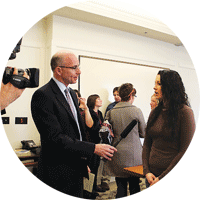Editor’s note: As we approached Ramadan this year, I realized that I was woefully ignorant of how Muslims celebrate this important holiday and why. I reached out to see if someone from the Solid Ground team would write about their experience of Ramadan. Abdel Elfahmy volunteered! Abdel, a practicing Muslim, is an Operations Supervisor at Solid Ground Transportation. I am grateful to him for sharing his perspective.
Whenever the month of Ramadan begins and the sighting of its crescent is affirmed, this marks the celebration of the willpower and strong determination of every Muslim. (This year’s Ramadan began the evening of June 17 and is over the evening of July 17.) Muslims fast from sun rise to sun set throughout the month of Ramadan out of obedience to their Lord and their urge to benefit from such a great spiritual experience. Muslims embark on a month-long spiritual journey of purification, hoping to disclose the wisdom behind fasting and obtain the abundant rewards of this blessed month, the fasting of which is one of the pillars of Islam.
The following are some of the rationales for fasting in this month:
1) The month of Ramadan is a practical self-training process on the sincerity and honesty of the believer: The one who breaks the fast is breaching the pledge with Allah, therefore fasting improves and increases his sense of honesty when he refrains from anything that could break his fast even whilst in seclusion. Of course one is not forced to fast in the month of Ramadan (there is no authority to check man’s behavior or compel him to observe fasting). One may pretend to be fasting in front of people, if his heart does not have any fear of his Lord. Fasting is an act of worship that is offered to the Creator with full devotion and sincerity, hoping only for the rewards from him.
2) Strengthening one’s willpower and determination: One who can tolerate the pain of hunger and thirst, and controls himself from having a sexual relation with his/her spouse whilst fasting, will strengthen determination and willpower. This frees the person from being enslaved to lusts and desires that are harmful. The month of Ramadan grounds a person in self-control. It is the month of radical positive change. When one fasts, one is in control of themself and exercises full control over habits and desires. Some people lose their temper and become ill-mannered if their meal was delayed from its normal time or if they do not drink their morning coffee or afternoon tea. They have become so accustomed to a certain routine that changing it creates a problem for them. Such people are slaves to their routine and habits, and fasting helps the person overcome this behavior.
3) Fasting is a holistic spiritual experience that poses a huge question mark for those who grasp the wisdom behind this obligation: A fasting person should ponder on the spirit of caring and sharing which fasting develops in Muslims. All fasting Muslims share the same pain, hunger, thirst and bitterness of deprivation while fasting with the poor and needy. Ramadan creates a social and humanitarian context that fosters compassion for the needy around the world. By our voluntary hunger and thirst, we realize what it means to be deprived of basic necessities of life. Ramadan is a time to remember and help those who are less fortunate. Moreover, all Muslims also feel the joy of breaking their fast and relish thankfulness to God. The poor people rejoice at their wealthy brothers who are sharing their pain and suffering with them. They rejoice at the thought that their wealthy brothers help them to ward off the scourge of hunger and bitter deprivation. Fasting rejuvenates the concept of social solidarity among the community.
4) Fasting generates in humans feelings of happiness, peace of mind and spiritual satisfaction, and fosters the unity of the community: It inculcates the real spirit of social belonging, of unity and brotherhood. When one fasts, one feels that he/she is joining the whole Muslim society in observing the same duty in the same manner at the same time for the same motives and to the same end.
5) Fasting is one of the greatest means to obtain forgiveness for sins and removal of misdeeds.
6) Realizing the size of the bounties of God: Fasting makes rich people appreciate the favors of Allah, because Allah has granted what He has deprived many other people from. Refraining from such bounties and blessings for a short period through fasting reminds the rich of those who are continuously deprived, and they thus become grateful to Allah and more merciful towards the needy.
7) Fasting has clear health and psychological benefits: These were disclosed after scientific discoveries were made, and from the insights of those who were blessed with insight and good understanding of the divine obligation. Some of these benefits are:
- It organizes the person’s heartbeat and relaxes it, since no blood is needed for digestion.
- It purifies the blood from fat and cholesterol and acids.
- It relieves the liver from the regular pressure.
- It reduces the production of the digestive glands, which is usually the cause for ulcers.
- It protects the person from weight gain, diabetes and kidney stones.
- It reduces the pressure on the heart arteries.
A fasting person spends his days in carrying out one of the greatest acts, devoting his days and nights during that holy month in remembrance, glorification and worship of Allah, and willfully rejecting all temptations, abominations and the cravings of the human body.
Filed under: My Story | Tagged: fasting, Muslim faith, Ramadan | Leave a comment »


































